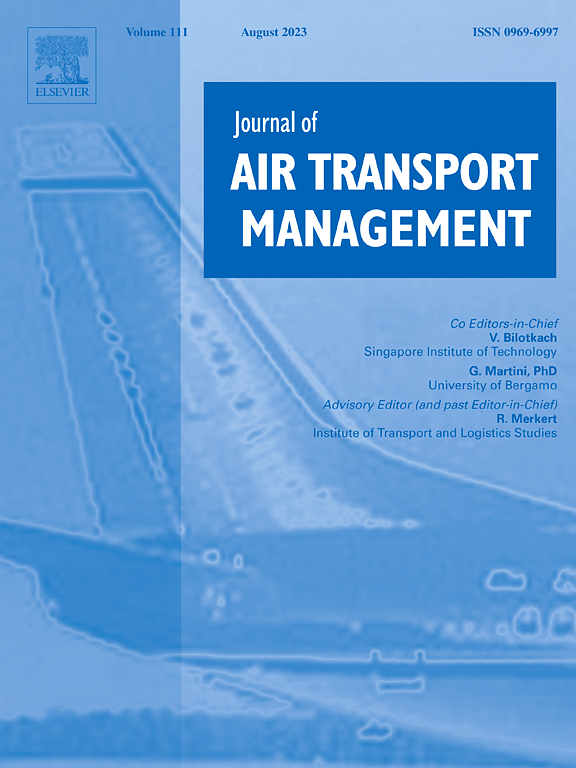利用监督学习动态预测单个航班的航班起飞延误概率分布
IF 3.6
2区 工程技术
Q2 TRANSPORTATION
引用次数: 0
摘要
对于任何一家航空公司来说,准点率都是一个关键的绩效指标,尤其是枢纽辐射型航空公司,因为它们关注的是短途客运。起飞时延误的航班需要补偿在空中损失的时间。由于加油早在预定起飞时间之前就开始了,因此预计的起飞延误决定了航路速度优化的计划燃油量。为了防止不必要的燃油消耗,航空公司从高度精确的起飞延误预测中获益。本研究旨在将航空公司离港延误预测扩展到动态和概率领域,同时结合新的航空公司运营日信息,以进一步减少预测误差。针对2020年1月1日至2023年8月1日期间一家大型轮辐航空公司从其枢纽机场出发的航班的案例研究,提出了随机森林、CatBoost和深度神经网络模型。随机森林模型在预测5 ~ 25分钟的延误时具有较高的概率性能和准确性,其中航路速度优化效果最大。在90 min预测范围内,模型的平均绝对误差为8.46 min,均方根误差为11.91 min。76%的航班实际延误在预测概率分布范围内。最后,本研究非常强调可解释性。因此,向飞行调度员提供了影响预测的主要因素,解释了飞行的背景。该模型的多功能性在一家国际航空公司的两次影子运行中得到了证明,其中成功预测了由熟悉和不熟悉因素引起的延误。本文章由计算机程序翻译,如有差异,请以英文原文为准。
Dynamically forecasting airline departure delay probability distributions for individual flights using supervised learning
Punctuality is a key performance indicator for any airline, especially hub-and-spoke airlines, given their focus on short passenger connections. Flights that are delayed at departure need to compensate for lost time whilst airborne. Because fuelling takes place well before scheduled departure, predicted departure delays determine the planned fuel amounts for en-route speed optimization. To prevent unnecessary fuel burn, airlines benefit from highly accurate departure delay predictions. This study aims to extend previous work on airline departure delay forecasting to a dynamic and probabilistic domain, whilst incorporating novel day-of-operations airline information to further minimize prediction errors. Random Forest, CatBoost, and Deep Neural Network models are proposed for a case study on departure flights of a major hub-and-spoke airline from its hub airport between 1 January 2020 and 1 August 2023. The Random Forest model is selected for its probabilistic performance and high accuracy in predicting delays between 5 and 25 min, for which en-route speed optimization has the largest effect. At the 90 min prediction horizon, the model reaches a Mean Absolute Error of 8.46 min and a Root Mean Square Error of 11.91 min. For 76% of flights, the actual delay is within the predicted probability distribution range. Finally, this study puts a strong emphasis on explainability. Flight dispatchers are therefore provided with the main factors impacting the prediction, explaining the context of the flight. The versatility of the model is demonstrated in two shadow runs within the procedures of an international airline, where delays caused by familiar and unfamiliar factors were successfully predicted.
求助全文
通过发布文献求助,成功后即可免费获取论文全文。
去求助
来源期刊

Journal of Air Transport Management
TRANSPORTATION-
CiteScore
12.40
自引率
11.70%
发文量
97
期刊介绍:
The Journal of Air Transport Management (JATM) sets out to address, through high quality research articles and authoritative commentary, the major economic, management and policy issues facing the air transport industry today. It offers practitioners and academics an international and dynamic forum for analysis and discussion of these issues, linking research and practice and stimulating interaction between the two. The refereed papers in the journal cover all the major sectors of the industry (airlines, airports, air traffic management) as well as related areas such as tourism management and logistics. Papers are blind reviewed, normally by two referees, chosen for their specialist knowledge. The journal provides independent, original and rigorous analysis in the areas of: • Policy, regulation and law • Strategy • Operations • Marketing • Economics and finance • Sustainability
 求助内容:
求助内容: 应助结果提醒方式:
应助结果提醒方式:


